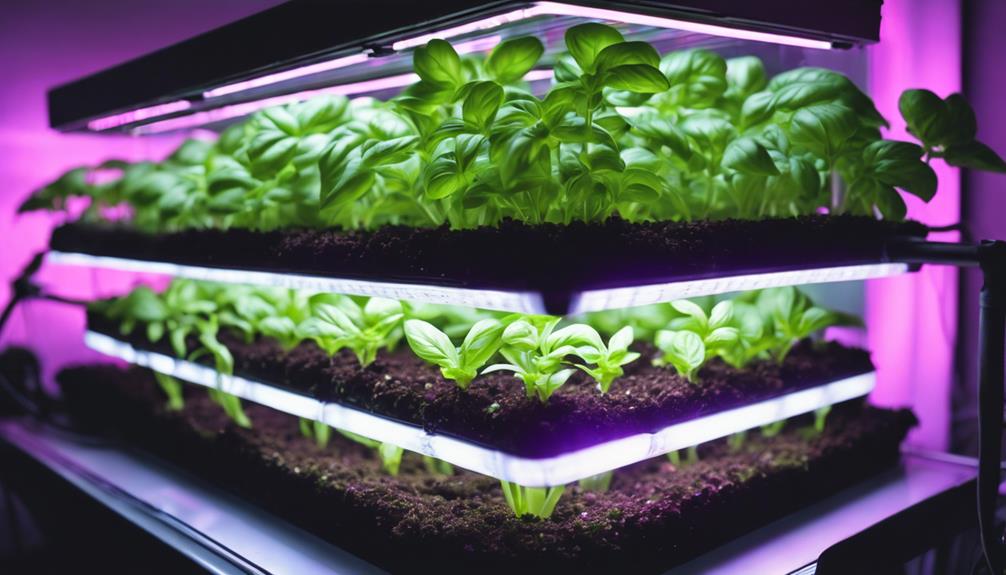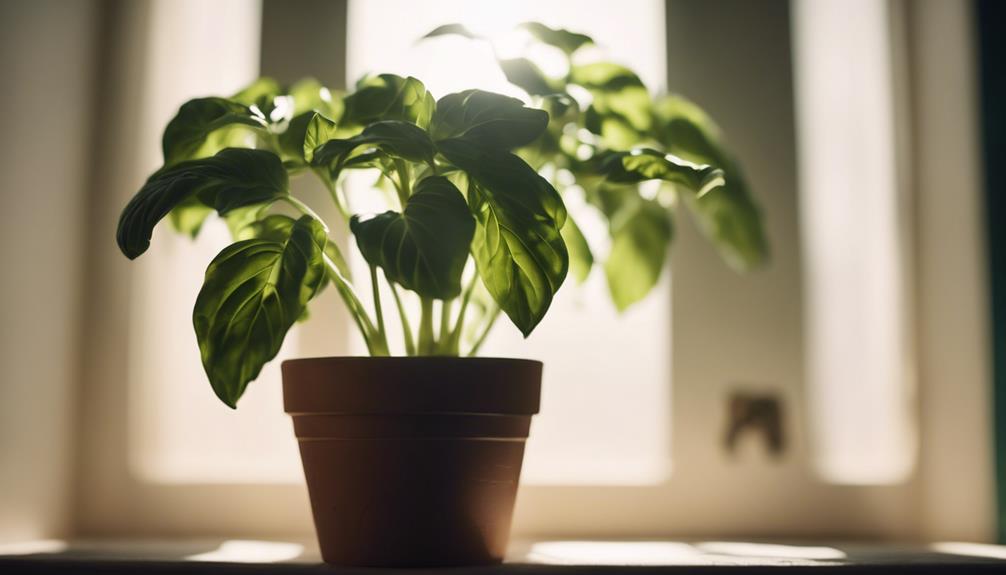Can you Grow Basil in the Sun Indoors?
How to grow basil in the sun indoors? First, provide sufficient LED grow lights positioned 12-18 inches above. Offer 14-16 hours of daily light. Be sure to monitor the light intensity for health.
Prepare nutrient-rich solutions with essential nitrogen, phosphorus, and potassium. Maintain pH levels around 5.5-6.5 for prime growth. Balance elements for robust plants and delicious flavor.
Keep basil soil moist without waterlogging, providing required light and nutrients. Regulate pH within 5.5-6.5 and focus on pruning and monitoring for thriving plants. With careful attention to lighting and nutrients, successful indoor basil cultivation awaits.
Check out the quiz at the end of this post once you’ve read the post!
GrowHydroHerbs TLDR
- Utilize LED grow lights with full spectrum for indoor sunlight simulation.
- Maintain 12-16 hours of light exposure daily for healthy basil growth.
- Position lights 6-12 inches above basil plants to mimic sun intensity.
- Ensure consistent light duration and distance for robust indoor basil.
- Optimize light source management to prevent stress and promote flourishing basil.
What Are the Benefits of Hydroponic Basil?
Hydroponic basil benefits from a nutrient-rich growth medium. This promotes rapid plant growth and enhanced flavor.
Additionally, hydroponic systems allow for year-round harvests. This provides a steady supply of fresh basil regardless of the season.
Enjoy the convenience and sustainability of hydroponic basil cultivation in your indoor space.
Nutrient-Rich Growth Medium
Utilize a nutrient-enriched growth medium in a hydroponic system. This is crucial to maximize the growth and flavor of your hydroponic basil,
The medium allows for efficient nutrient absorption by the basil plants.
The controlled environment of hydroponics ensures that your basil plants receive balanced nutrition. Thus, promoting root health, plant vitality, and overall well-being.
Tailor the nutrient solution to meet the specific requirements of the basil plants. Then you can enhance their growth rate and flavor profile significantly.
The nutrient-enriched growth medium minimizes the risk of soil-borne diseases and pests. This provides a healthier environment for your basil plants to thrive.
Keep a nutrient-enriched medium in your hydroponic setup. Then you can enjoy a bountiful harvest of fresh and flavorful basil year-round.
Year-Round Fresh Harvest
Growing hydroponic basil indoors allows you to enjoy a basil. It becomes a continuous supply of fresh and flavorful herbs throughout the year. Doesn’t matter if it’s hot or snowing outside.
Seasonal flexibility is a key advantage of indoor gardening with hydroponic systems. It allows you to have access to fresh herbs even during the winter months.
Adopt sustainable practices like hydroponic basil cultivation. Then you contribute to a more environmentally friendly way of growing plants.
Hydroponics systems guarantee the amounts of nutrients and water that basil plants require. This leads to faster growth and higher yields.
Indoor hydroponic basil cultivation provides a constant source of fresh herbs. Right in your house, right at your fingertips. This makes it convenient for everyday use in your cooking. Embrace the benefits of year-round fresh harvests. Incorporate hydroponic basil into your indoor gardening routine.
How Do You Set Up Your Hydroponic System for Growing Basil?

To set up your hydroponic system for growing basil indoors, follow these steps:
- Gather the necessary equipment.
- Choose a suitable hydroponic system like DWC, NFT, or a Wick system.
- Prepare a nutrient solution. Maintain proper pH levels and nutrient concentration for healthy growth.
- Provide sufficient lighting.
Equipment Needed
Equip yourself with a hydroponic system, including:
- grow lights
- nutrient solution
- growing medium
- pH and EC meters
- water pump,
This will help to set up your indoor basil cultivation successfully.
Grow lights are essential for providing the necessary light spectrum for basil growth. This is especially true in indoor settings.
The right nutrient solution is essential for healthy basil plants. Be sure to choose a balanced formula suitable for hydroponic cultivation.
Select a suitable growing medium like rock wool or perlite. This will support the plants and allow proper root aeration.
pH levels are critical for plant nutrient uptake. Be sure to use a pH meter to monitor and adjust the levels accordingly.
The water pump helps circulate the nutrient solution. It ensures all roots receive essential nutrients.
These equipment pieces are necessary for creating an ideal environment for your basil plants to thrive indoors.
These are some of the right tools to have in place. Then, you can effectively manage the elements for successful hydroponic basil cultivation.
Nutrient Solution Preparation
Prepare your nutrient solution with a balanced pH level between 5.5-6.5 for ideal basil growth in a hydroponic system.
It’s important to mix the nutrient ratios correctly at each growth stage. This will guarantee your basil plants receive the necessary nutrients.
Adjust the solution concentration based on the development phase of your basil. This will support healthy growth.
Monitor the solution regularly. Maintain the correct pH balance and nutrient levels. This will prevent deficiencies and promote robust growth.
Following a set nutrient schedule is essential. Be sure to change the solution every 2-3 weeks. This will provide a consistent supply of essential nutrients to your hydroponic basil plants.
By adhering to these practices, you can optimize the growth of your basil indoors under controlled conditions. Thus, allowing you to enjoy fresh and flavorful basil year-round.
Lighting Requirements
How to ensure your basil plants thrive indoors in a hydroponic system? Provide adequate lighting that mimics natural sunlight. Basil plants require specific lighting conditions to grow successfully.
Here are essential factors to keep in mind:
| Lighting Aspect | Recommendation |
|---|---|
| Light Spectrum | Opt for LED grow lights with a spectrum of 450-650 nm to mimic natural sunlight for best growth. |
| Light Distance | Position grow lights 12-18 inches above basil plants to prevent burning and ensure even light distribution. |
| Light Schedule | Maintain a consistent lighting schedule of 14-16 hours of light per day to simulate daylight conditions. |
| Light Intensity | Regularly monitor light intensity levels to make sure basil plants receive adequate light for healthy development and maximum yield. |
What Are The Lighting Requirements for Indoor Basil?

To guarantee your indoor basil plants prosper, they need a minimum of 6-8 hours of sunlight daily or the equivalent from grow lights. Position your basil near a sunny window if possible. Otherwise, utilize LED grow lights with the right spectrum for best growth.
Balancing light duration and intensity is essential for healthy basil plants year-round.
Sunlight for Indoor Basil
For the best development of your indoor basil plants, make sure they receive a minimum of 6-8 hours of sunlight daily. Preferably from a south-facing window or supplemented with LED grow lights if necessary.
- Sunlight benefits: Sunlight provides essential energy for basil plants. This allows them to carry out photosynthesis and develop strong, flavorful leaves.
- Indoor gardening: Growing basil indoors allows you to enjoy fresh herbs year-round. This is true even in limited spaces or unfavorable outdoor conditions.
- Light spectrum: LED grow lights with a spectrum of 450-650 nm mimic the natural sunlight needed for ideal basil growth.
- Light rotation: Rotate your basil plants regularly. This will guarantee all sides receive equal light exposure. Thus, promoting balanced and healthy growth.
Grow Lights for Basil
Make sure your indoor basil plants receive the necessary 12-16 hours of light daily. Do this by selecting high-quality grow lights suitable for best growth. When considering LED vs T5 grow lights, LED lights are energy-efficient and provide a full spectrum of light suitable for basil.
On the other hand, T5 fluorescent lights offer a balanced spectrum and emit less heat. Proper ventilation is important. This is especially true with lights that emit more heat like metal halide or high-pressure sodium options.
Position the grow lights 6-12 inches above the basil plants to ensure they receive adequate light without stretching. When comparing energy efficiency, LED lights are the better choice. They consume less power while still providing the necessary light for optimal growth.
Consider these factors when choosing grow lights for your indoor basil. This will create the perfect environment for your plants to flourish:
| Grow Lights | Energy Efficiency | Heat Emission | Proper Ventilation |
|---|---|---|---|
| LED | High | Low | Good |
| T5 | Moderate | Low | Good |
| Metal Halide | Moderate | High | Adequate |
| HPS | Moderate | High | Adequate |
Light Duration Needed
Peak growth for indoor basil plants necessitates providing them with artificial grow lights. A duration of 12-16 hours daily mimics the natural sunlight the basil plants require.
The following lighting requirements helps to ensure the best growth for your indoor basil:
- Light duration: Provide artificial grow lights for 12-16 hours daily. This mimics sunlight exposure.
- Growth optimization: Adjust the distance and duration of the light source. This will prevent light stress and promote healthy development.
- Sunlight exposure: Mimic the natural sunlight basil plants need. Use LED grow lights with the full spectrum of light.
- Artificial lighting: Position the light source 6-12 inches above the basil plants. This will prevent stretching and encourage compact growth.
What Nutrient Solution Do You Need for Basil Growth?

To guarantee your basil plants thrive indoors, it’s vital to provide them with the proper nutrient solution. This solution would contain essential components like nitrogen, phosphorus, and potassium.
Prepare a balanced nutrient solution within the ideal EC range of 1.0-1.6. Maintain a pH level between 5.5-6.5. These can promote healthy growth and prevent nutrient deficiencies in your basil plants.
Understanding how to prepare and adjust a nutrient solution tailored to your basil’s growth stages. This is key to cultivating robust plants with vibrant leaves for year-round enjoyment.
Essential Nutrient Components
Certain nutrient components are required for optimal basil growth in a hydroponic system. These include nitrogen, phosphorus, potassium, calcium, and magnesium. These elements are vital for maintaining a nutrient balance. This nutrient mix promotes growth. It supports leaf development and root health. Further, it enhances the flavor of your basil.
Here are some key points to keep in mind:
- Nutrient Balance: Balancing the levels of nitrogen, phosphorus, potassium, calcium, and magnesium. This is fundamental for overall plant health and growth.
- Growth Promotion: These nutrients work together. They stimulate robust growth and development in your basil plants.
- Leaf Development: Maintain the proper levels of these essential component. It helps to support the growth of vibrant and healthy basil leaves.
- Root Health: Ensure your basil receives adequate nutrients. This helps maintain strong and healthy root systems.
Nutrient Solution Preparation
The proper nutrient solution is important for peak basil growth in a hydroponic system. Make sure your nutrient solution contains essential elements like:
- nitrogen
- phosphorus
- potassium
- calcium
- magnesium.
The nutrient balance is vital for supporting the growth development of your basil plants.
To guarantee optimal nutrient uptake, adjust the pH levels of the solution to fall between 5.5-6.5. Additionally, monitor the electrical conductivity (EC) of the nutrient solution. The aim is to maintain it between 1-1.6 for proper nutrient levels.
Regularly check and adjust the nutrient solution. This will ensure that your basil plants receive all the necessary nutrients for vigorous growth. Pay attention to these aspects of nutrient solution preparation. By doing so, you’re setting up your hydroponic system for success in cultivating healthy and flavorful basil indoors.
How Do You Maintain Healthy Basil Plants?

The goal is to maintain healthy basil plants. To do so, make sure they receive an adequate supply of water and nutrients, keeping the soil consistently moist but not waterlogged.
Additionally, provide sufficient light for at least 6-8 hours a day. It can be either from natural sunlight near a window or artificial grow lights. This will support the basil plant’s growth and development.
A balanced combination of water, nutrients, and light is essential for thriving basil plants indoors.
Water and Nutrients
Maintain an ideal pH range of 5.5-6.5 for your basil plants’ nutrient solution. This is crucial for their healthy growth and nutrient absorption.
To optimize your basil plants thrive, here are some key practices to keep in mind:
- pH Regulation: Regularly monitor and adjust the pH of the nutrient solution. This will maintain the best range for basil growth.
- Nutrient Monitoring: Keep an eye on the electrical conductivity (EC) of the solution. This will optimize the right nutrient levels for your plants.
- Temperature Control: Maintain a stable reservoir temperature between 68-75°F. This will support the overall health and growth of your hydroponic basil.
- Pruning Techniques: Regularly prune your basil plants. This will encourage healthy growth. Thus, preventing overcrowding, and improving air circulation and light exposure.
Adequate Light Supply
Sufficient lighting is necessary for ensuring the health and vigor of your indoor basil plants. To maintain healthy basil plants, it is important to provide adequate natural sunlight or artificial light sources. Proper positioning of your basil plants plays a key role in receiving the required light intensity and spectrum.
Here are some key factors to bear in mind for maintaining healthy basil plants indoors:
| Factors | Guidelines |
|---|---|
| Natural sunlight | Basil plants need at least 6-8 hours of sunlight daily for best growth. |
| Proper positioning | Position basil plants near a window or under grow lights, keeping them 6-12 inches away from the light source. |
| Light spectrum | Use grow lights with a range of 450-650 nm, ideal for basil plant growth. |
| Light intensity | LED grow lights are energy-efficient and provide the necessary light strength for indoor basil cultivation. |
| Preventing leggy growth | Close proximity to the light source helps prevent leggy growth in basil plants. |
What About Successful Basil Harvesting? Here Are Some Tips!

Regularly harvesting basil leaves is crucial for encouraging new growth and maintaining plant health. To foster a successful basil harvest, consider the following tips:
- Pruning techniques: Trim basil stems just above a pair of leaves to promote bushier growth and prevent legginess.
- Aromatic herb: You can enjoy the delightful fragrance of freshly gathered basil. Do this by gently crushing the leaves before use in various dishes.
- Pesto recipes: Whip up delicious homemade pesto. Use freshly harvested basil leaves, pine nuts, garlic, Parmesan cheese, olive oil, and a pinch of salt.
- Companion planting: Plant basil near tomatoes, peppers, or oregano. This will enhance their flavor and repel pests effectively.
Grow Basil In the Sun?
Growing basil hydroponically indoors allows you to enjoy fresh and flavorful herbs year-round. You don’t have to worry about the weather outside.
By providing the right lighting, nutrient solution, and care, you can cultivate healthy basil plants that will enhance your culinary creations.
With these simple techniques, you can easily master the art of growing basil in the sun indoors and elevate your cooking experience.
Here is a quick quiz to help you see if you know the facts:
Happy harvesting!


